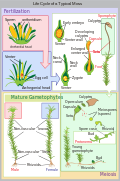Moss
Mosses are bryophytes, a group of plants without tissue to move water. Mosses evolved from liverworts.[2]p75
| Bryophyta | |
|---|---|

| |
| Clumps of moss on the ground and base of trees in the Allegheny National Forest, Pennsylvania, USA. | |
| Scientific classification | |
| Kingdom: | |
| Division: | Bryophyta |
| Classes | |
| Synonyms | |
| |
Moss tissue does not have cells that move water. This means that they are non-vascular plants. Water must soak into mosses like a sponge. A patch of moss is made of many tiny moss plants packed together so that they can hold water for as long as possible. They do not have roots. Because mosses cannot find water, they live in two ways. They can live in places that are always wet like near a spring, a river, or in a place where there is a lot of fog or has a lot of rainfall. They can also pause their natural processes when they dry up. Mosses can survive months in this paused state. However, they eventually need water to live. This means they can never live in dry places like deserts.
Mosses cannot grow very large because they could not move water to the top of their growth. The largest moss grows in New Zealand. It is about 30 cm tall.
A moss does not make seeds. A moss does not have fruit. The green fuzzy part of a moss that is always there has only one set of DNA. Moss waits until there is lots of food and enough water. Then it produces spores that leave the parent plant and float away. The spores are like dust. They will make more moss. Each spore is male or female. It grows into the green fuzzy part of the moss called the gametophyte. Male gametophyte make sperm. Female gametophyte make eggs. Water moves the sperm from the male moss to the female moss. Then the sperm and the egg join to make a cell with two sets of moss DNA. This cell grows into a different shape called a sporophyte. The sporophyte gets all of its food from the green fuzzy female gametophyte. When the sporophyte grows up, it makes a tiny box with spores inside instead of seeds. The lid on the box falls and the spores float away to repeat the cycle again. This process is called alternation of generations.
Scientists divide the mosses into eight groups. Five of these groups are small, with just a few species; most mosses are in the group called Bryopsida.
Moss Media
Chloroplasts (green discs) and accumulated starch granules in cells of Bryum capillare
Moss leaf under microscope, showing gemmae (40x)
Life cycle of a typical moss (Polytrichum commune)
"Muscinae" from Ernst Haeckel's Kunstformen der Natur, 1904
Bristly Haircap moss, a winter native of the Yorkshire Dales moorland
Moss bioreactor cultivating the moss Physcomitrella patens
References
- ↑ Hubers, M.; Kerp, H. (2012). "Oldest known mosses discovered in Mississippian (late Visean) strata of Germany". Geology. 40 (8): 755–758. Bibcode:2012Geo....40..755H. doi:10.1130/G33122.1.
- ↑ Willis K.J. and McElwain J.C. 2002. The evolution of plants. Oxford.
Other websites
 Media related to Bryophyta at Wikimedia Commons
Media related to Bryophyta at Wikimedia Commons Data related to Bryophyta at Wikispecies
Data related to Bryophyta at Wikispecies The dictionary definition of moss at Wiktionary
The dictionary definition of moss at Wiktionary









